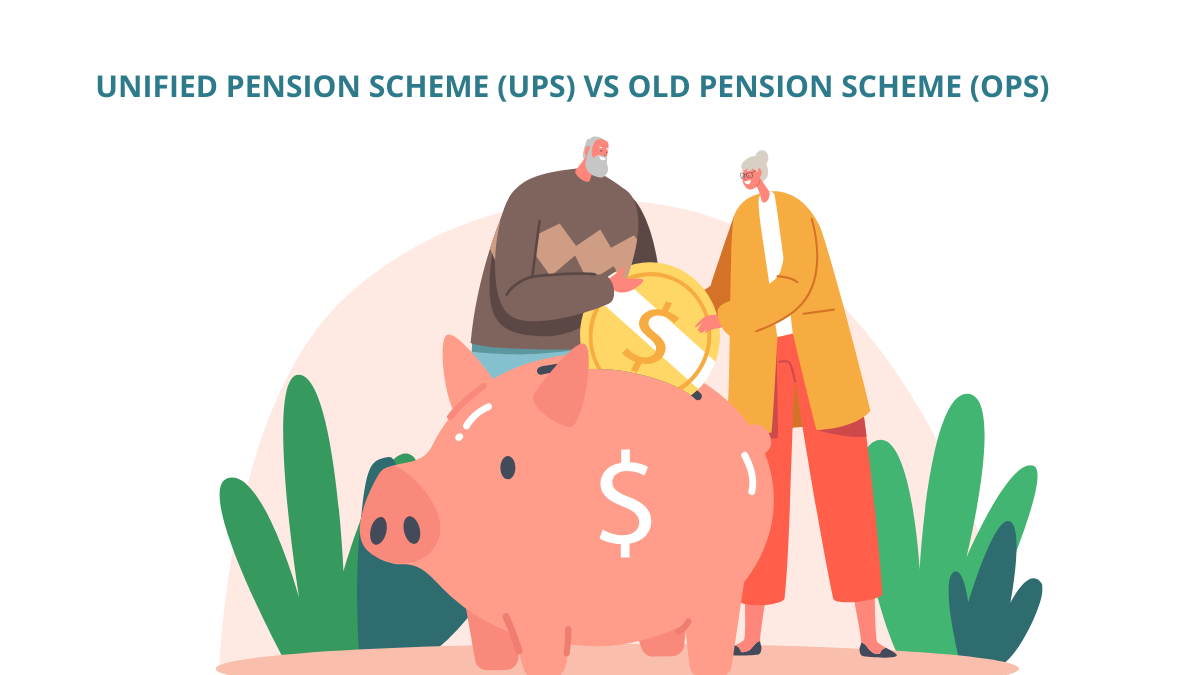Unified Pension Scheme (UPS) vs Old Pension Scheme (OPS): A Comprehensive Comparison [Current Affairs]
The Indian government’s recent approval of the Unified Pension Scheme (UPS) has generated significant interest, particularly among government employees. While the UPS incorporates elements from the Old Pension Scheme (OPS), it introduces several key changes that affect employees in both beneficial and challenging ways. This article provides a detailed comparison of these two pension schemes, highlighting their similarities, differences, and potential impacts on government employees and the nation’s finances.
Historical Context: The Old Pension Scheme (OPS)
Overview of the OPS
The Old Pension Scheme, in effect before 2004, was a defined benefit pension system that provided government employees with a secure and predictable retirement income. Under this scheme, retirees received a pension equivalent to 50% of their last drawn salary, fully funded by the government without requiring any contributions from employees during their service.
Key Features of the OPS
- No Employee Contributions: Government employees were not required to contribute to their pension fund during their service.
- Government-Funded: The entire pension amount was funded by the government, placing a significant financial burden on state coffers.
- Defined Benefit: Retirees received a fixed percentage (50%) of their last drawn salary as pension, providing a clear and predictable retirement income.
- Family Pension: The OPS included provisions for family pension, typically at a lower percentage of the employee’s pension upon their demise.
- Inflation Adjustment: The OPS incorporated dearness relief to adjust pensions for inflation, although the system was less standardized compared to modern indexation methods.
Challenges of the OPS
While the OPS provided a sense of security to government employees, it posed significant challenges:
- Fiscal Burden: The scheme placed an enormous financial strain on government resources, as the entire pension liability was borne by the state.
- Lack of Sustainability: With increasing life expectancy and a growing number of retirees, the OPS became increasingly unsustainable in the long term.
- Inequity: The scheme favored employees who received promotions or salary hikes close to retirement, potentially creating disparities among pensioners.
The Unified Pension Scheme (UPS): A New Approach
Introduction and Implementation
The Unified Pension Scheme, set to take effect from April 1, 2025, represents a significant shift in India’s approach to government employee pensions. The UPS aims to address the shortcomings of the OPS while retaining some of its beneficial features.
Key Features of the UPS
- Contributory Model: Unlike the OPS, the UPS requires employees to contribute 10% of their salary towards their pension fund. The government will contribute an additional 18.5%, creating a shared financial responsibility.
- Guaranteed Pension: The UPS guarantees a pension based on 50% of the average basic pay over the last 12 months before retirement, similar to the OPS.
- Minimum Pension: The scheme introduces a guaranteed minimum pension of ₹10,000 per month for employees with at least 10 years of service.
- Enhanced Family Pension: Under the UPS, family pension benefits are set at 60% of the employee’s pension upon their demise, a more generous provision compared to the OPS.
- Inflation Protection: The UPS includes inflation indexation based on the All India Consumer Price Index for Industrial Workers (AICPI-IW), ensuring that pensions adjust for inflation in a standardized manner.
- Lump Sum Payment: The UPS provides for a lump sum payment at retirement, adding an extra layer of financial security for retirees.
Comparative Analysis: UPS vs OPS
Pension Calculation and Guaranteed Amount
Both the UPS and OPS offer a pension based on 50% of the salary. However, the UPS calculates this based on the average of the last 12 months’ basic pay, while the OPS used the last drawn salary. The UPS’s introduction of a minimum ₹10,000 monthly pension provides a safety net not explicitly defined in the OPS.
Employee Contributions
The most significant departure from the OPS is the UPS’s requirement for employee contributions. While this may be seen as a disadvantage by some employees, it helps ensure the long-term sustainability of the pension system and aligns with modern pension schemes globally.
Family Pension Benefits
The UPS offers a more generous family pension at 60% of the employee’s pension, compared to the typically lower percentages under the OPS. This enhancement provides better financial security for the families of deceased pensioners.
Inflation Protection
While both schemes include provisions for inflation adjustment, the UPS’s use of the AICPI-IW for indexation provides a more standardized and potentially more responsive approach to maintaining the purchasing power of pensions over time.
Implications and Considerations
For Employees
- Financial Planning: The contributory nature of the UPS necessitates more active financial planning by employees during their service years.
- Enhanced Benefits: The UPS offers improved benefits in terms of family pension and inflation protection, potentially providing better long-term financial security.
- Minimum Guarantee: The introduction of a minimum pension amount offers a safety net, particularly beneficial for lower-paid employees.
For the Government
- Fiscal Responsibility: The UPS helps distribute the financial burden of pensions between the government and employees, potentially improving fiscal sustainability.
- Long-term Sustainability: By incorporating employee contributions and modern indexation methods, the UPS is designed to be more sustainable in the face of demographic changes and increasing life expectancy.
- Balancing Act: The government must carefully manage the transition to ensure that current and future employees understand and accept the new scheme.
Source: currentaffairs by adda247
